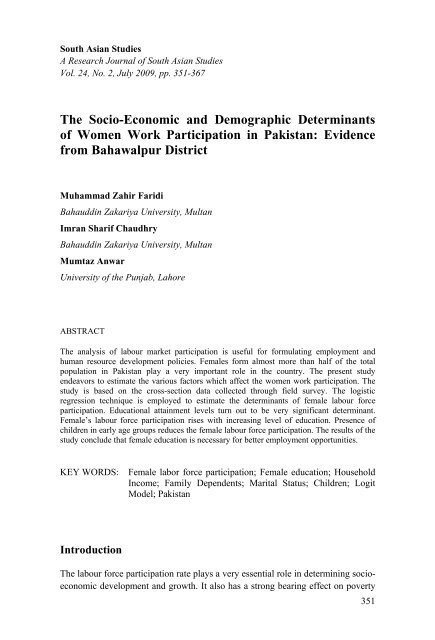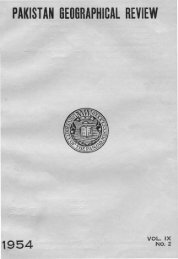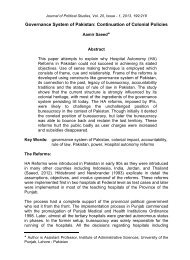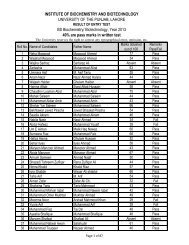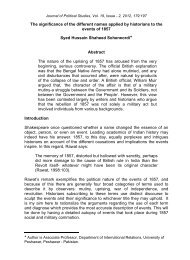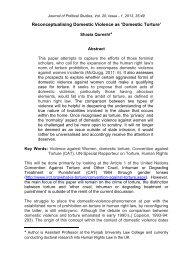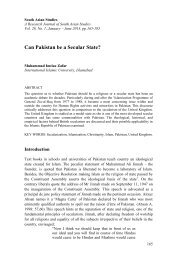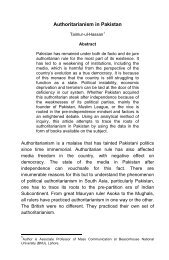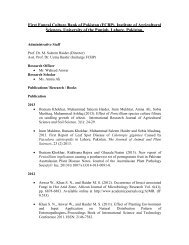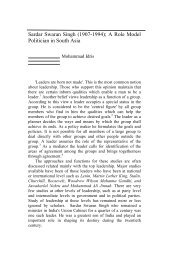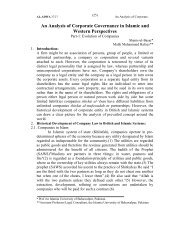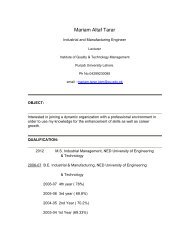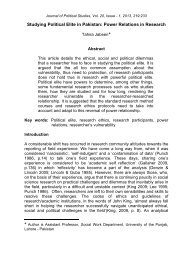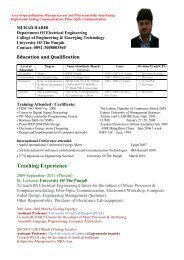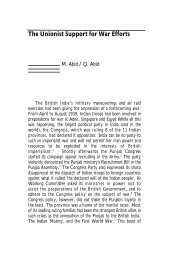The Socio-Economic and Demographic Determinants of Women ...
The Socio-Economic and Demographic Determinants of Women ...
The Socio-Economic and Demographic Determinants of Women ...
You also want an ePaper? Increase the reach of your titles
YUMPU automatically turns print PDFs into web optimized ePapers that Google loves.
South Asian Studies<br />
A Research Journal <strong>of</strong> South Asian Studies<br />
Vol. 24, No. 2, July 2009, pp. 351-367<br />
<strong>The</strong> <strong>Socio</strong>-<strong>Economic</strong> <strong>and</strong> <strong>Demographic</strong> <strong>Determinants</strong><br />
<strong>of</strong> <strong>Women</strong> Work Participation in Pakistan: Evidence<br />
from Bahawalpur District<br />
Muhammad Zahir Faridi<br />
Bahauddin Zakariya University, Multan<br />
Imran Sharif Chaudhry<br />
Bahauddin Zakariya University, Multan<br />
Mumtaz Anwar<br />
University <strong>of</strong> the Punjab, Lahore<br />
ABSTRACT<br />
<strong>The</strong> analysis <strong>of</strong> labour market participation is useful for formulating employment <strong>and</strong><br />
human resource development policies. Females form almost more than half <strong>of</strong> the total<br />
population in Pakistan play a very important role in the country. <strong>The</strong> present study<br />
endeavors to estimate the various factors which affect the women work participation. <strong>The</strong><br />
study is based on the cross-section data collected through field survey. <strong>The</strong> logistic<br />
regression technique is employed to estimate the determinants <strong>of</strong> female labour force<br />
participation. Educational attainment levels turn out to be very significant determinant.<br />
Female’s labour force participation rises with increasing level <strong>of</strong> education. Presence <strong>of</strong><br />
children in early age groups reduces the female labour force participation. <strong>The</strong> results <strong>of</strong> the<br />
study conclude that female education is necessary for better employment opportunities.<br />
KEY WORDS: Female labor force participation; Female education; Household<br />
Income; Family Dependents; Marital Status; Children; Logit<br />
Model; Pakistan<br />
Introduction<br />
<strong>The</strong> labour force participation rate plays a very essential role in determining socioeconomic<br />
development <strong>and</strong> growth. It also has a strong bearing effect on poverty<br />
351
M. Zahir Faridi, Imran Sharif Ch. & Mumtaz Anwar <strong>The</strong> <strong>Socio</strong>-<strong>Economic</strong><br />
reduction. <strong>The</strong> labour force participation rate shows the supply <strong>of</strong> labour in the<br />
economy <strong>and</strong> the composition <strong>of</strong> the human resources <strong>of</strong> the country. <strong>The</strong> analysis<br />
<strong>of</strong> the labour force participation is helpful in determining employment policy <strong>and</strong><br />
policy formulation for human resource development. Females constitute about half<br />
<strong>of</strong> the total population in Pakistan <strong>and</strong> play a very significant role in the economy.<br />
<strong>The</strong> trend <strong>and</strong> structure <strong>of</strong> the female labour force participation (FLFP) has<br />
attracted attention over the past few decades in the world <strong>and</strong> from the past few<br />
years in the Pakistan. <strong>The</strong> incidence <strong>of</strong> women work participation is low in<br />
Pakistan. Although the average annual growth rate <strong>of</strong> women work participation is<br />
rising slightly in Pakistan, which was 15.9 percent during the period 2003-04 <strong>and</strong><br />
has gone up to 18.9% during the period 2005-06 1 . But still women work<br />
participation is very low as compared to the south Asian countries.<br />
This study is an effort to identify the socio-economic <strong>and</strong> demographic factors<br />
which determine the women work participation. This issue has been analyzed in<br />
many studies 2 but these studies have been generally failed to incorporate various<br />
socio-economic <strong>and</strong> demographic variables in their analysis. In the present study,<br />
we have attempted to analyze the relationship <strong>of</strong> age pr<strong>of</strong>ile <strong>of</strong> the women <strong>and</strong> all<br />
levels <strong>of</strong> education with work participation <strong>of</strong> the females in some detail.<br />
<strong>The</strong> study is planned into five sections. Introduction is presented in the first<br />
section. <strong>The</strong> second section provides the review <strong>of</strong> literature. In the third section,<br />
we have discussed methodology, data sources <strong>and</strong> variables. <strong>The</strong> results <strong>of</strong> the<br />
estimation are presented in the fourth section. We have <strong>of</strong>fered some concluding<br />
remarks <strong>and</strong> policy implications in the last section.<br />
Literature Review<br />
Literature review on labor force participation <strong>and</strong> supply <strong>of</strong> labor both at national<br />
<strong>and</strong> international level is discussed in this section. A number <strong>of</strong> studies can be<br />
observed in the literature relating to the economic theory <strong>of</strong> the household. Becker<br />
(1965) <strong>and</strong> Gronau (1977) is the beginner <strong>of</strong> the field <strong>and</strong> explained the household<br />
behavior regarding time allocation. However, a vast variety <strong>of</strong> literature based on<br />
empirical studies especially for developed nations is available. Most <strong>of</strong> them are<br />
survey based <strong>and</strong> these surveys are carried by Macurdy, Heckman (1980) <strong>and</strong><br />
Heckman <strong>and</strong> Killingworth (1986).<br />
Mincer (1962) has discussed the relationship between working hours <strong>and</strong><br />
female labor force participation overtime. He has explored that wife’s dem<strong>and</strong> for<br />
leisure is not influenced by income <strong>of</strong> the family. <strong>The</strong> probability <strong>of</strong> labor force<br />
participation <strong>and</strong> lifetime wealth measures are inversely related. <strong>The</strong> study<br />
concludes that number <strong>of</strong> children significantly influences the female labor force<br />
participation decision.<br />
Shah et al. (1976) has studied the effects <strong>of</strong> some selected demographic <strong>and</strong><br />
socio-economic variables on labor force participation in all the provinces <strong>of</strong><br />
352
South Asian Studies 24 (2)<br />
Pakistan. <strong>The</strong> results show that the labor force participation is negatively related<br />
with nuclear family type <strong>and</strong> child-women ratio. <strong>The</strong> study indicates that there is<br />
direct relationship between labor force participation <strong>and</strong> marital status. He also has<br />
found that dependency ratio <strong>and</strong> literacy ratio have positive influence on labor<br />
force participation.<br />
Kozel <strong>and</strong> Alderman (1990) have analyzed the factors affecting work<br />
participation <strong>and</strong> labor supply decision in the urban areas <strong>of</strong> Pakistan. He has used<br />
OLS regression <strong>and</strong> Tobit model to estimate the correlates. <strong>The</strong> study concludes<br />
that the women work participation rises with an increase in the expected earning,<br />
wages <strong>and</strong> level <strong>of</strong> education.<br />
Malik et al. (1994) has investigated the factors, which influence female labor<br />
force participation in economic activities. He has explored that women’s age,<br />
education <strong>and</strong> the number <strong>of</strong> dependents do not significantly determine market<br />
time. <strong>Women</strong> labor supply is significantly <strong>and</strong> positively affected by women wage<br />
rate <strong>and</strong> predicted male wage rate.<br />
Aly <strong>and</strong> Quisi (1996) has discussed socio-economic factors that affect<br />
Kuwaiti women’s labor market participation decision. <strong>The</strong> study concludes that<br />
females’ wage rate <strong>and</strong> education are positively related with labor force<br />
participation rate. It has been also found that marital status, the number <strong>of</strong> children<br />
<strong>and</strong> age is inversely related with labor force participation rate.<br />
Azid et al. (2001) have studied the factors influencing female participation in<br />
cottage industry <strong>of</strong> Pakistan. <strong>The</strong> main objective <strong>of</strong> the study is to analyze the<br />
economic behavior <strong>of</strong> the female workers involved in the business <strong>of</strong> embroidery.<br />
<strong>The</strong> study has concluded that number <strong>of</strong> the children, age <strong>of</strong> the females,<br />
education, poverty status have a positive <strong>and</strong> significant impact on female labor<br />
force participation.<br />
Naqvi <strong>and</strong> Shahnaz (2002) have examined the effects <strong>of</strong> various demographic,<br />
socio-economic <strong>and</strong> human capital related factors on women participation in<br />
economic activities. <strong>The</strong>y have used cross-sectional data from integrated<br />
household survey (PIHS) (1998-99) for the age group <strong>of</strong> 15-49 years. <strong>The</strong> probit<br />
<strong>and</strong> multinomial logit model has been used to estimate the parameters. <strong>The</strong> probit<br />
estimates indicate that marital status, primary education, number <strong>of</strong> children <strong>and</strong><br />
female head <strong>of</strong> households are inversely related with women’s participation in<br />
economic activities.<br />
Khan et al. (2005) have focused on hazardous nature <strong>of</strong> home-based work <strong>of</strong><br />
women <strong>and</strong> children. <strong>The</strong>y have investigated the contribution <strong>of</strong> women <strong>and</strong><br />
children to the total family income <strong>and</strong> the impact <strong>of</strong> increased income on raising<br />
household nutrition, health <strong>and</strong> education. <strong>The</strong> study has concluded that household<br />
size is significantly <strong>and</strong> positively influencing the decision <strong>of</strong> household to engage<br />
in home-based work while living condition index inversely.<br />
Chaudhry <strong>and</strong> Nosheen (2009) analyzed the determinants <strong>of</strong> women<br />
empowerment in Southern Punjab <strong>of</strong> Pakistan. Considering multidimensional<br />
nature <strong>of</strong> women empowerment, authors estimated the cumulative index for<br />
353
M. Zahir Faridi, Imran Sharif Ch. & Mumtaz Anwar <strong>The</strong> <strong>Socio</strong>-<strong>Economic</strong><br />
women using four indices i.e. personal autonomy, family decision making,<br />
domestic economic decisions <strong>and</strong> political autonomy. <strong>The</strong> results demonstrated<br />
that women empowerment is considerably influenced by education, access to<br />
media, socio-cultural norms <strong>of</strong> the community, job <strong>of</strong> women <strong>and</strong> household<br />
participation rate. <strong>The</strong> major emphasis <strong>of</strong> this study was on the women<br />
empowerment in terms <strong>of</strong> their participation in household economic activities.<br />
Methodology, Data Sources <strong>and</strong> Selection <strong>of</strong> Variables<br />
<strong>The</strong> data for this study is collected through filed survey in the year (2007-2008),<br />
concentrating on the sample <strong>of</strong> female labor force ages 15-64 years. Female labor<br />
force economic activities are examined by studying the various household factors<br />
different socio-economic, demographic <strong>and</strong> human capital components are also<br />
considered. A sample <strong>of</strong> 164 female workers in the age cohorts <strong>of</strong> 15-64 years is<br />
r<strong>and</strong>omly drawn from urban as well as rural areas <strong>of</strong> Bahawalpure district. <strong>The</strong><br />
Bahawalpure is one <strong>of</strong> the southern parts <strong>of</strong> the province <strong>of</strong> Punjab <strong>and</strong> situated<br />
almost in the center <strong>of</strong> the country. It consists <strong>of</strong> five tehsils namely Bahawalpure,<br />
Ahmad Pure East, Yazman, Hasilpure <strong>and</strong> Khan pure Tamewali.<br />
<strong>The</strong> analysis <strong>of</strong> the study is carried out at two levels. First a statistical analysis<br />
<strong>of</strong> female labor force participation is carried out. Secondly, the labor force<br />
decision to participate in economic activities is modeled in the framework <strong>of</strong> the<br />
traditional theory <strong>of</strong> utility maximization (see Becker, 1965) by using the<br />
maximum likelihood logit estimation technique.<br />
Logit Model<br />
<strong>The</strong> inadequacy <strong>of</strong> linear probability model suggests that non-linear specification<br />
may be more appropriate. In order to explain the dichotomous dependent variable,<br />
we will use Logit model. <strong>The</strong> Logit model assumes the following cumulative<br />
probability density function:<br />
354<br />
1<br />
1+<br />
e<br />
P ( −βX<br />
)<br />
= ----------------------- (1)<br />
i<br />
Where ‘P’ is the probability that a person participates in the labor market, “e”<br />
is the exponential value. β is the row vector <strong>of</strong> the parameters <strong>and</strong> “Xi” is the<br />
column vector <strong>of</strong> the variables.<br />
Since ‘P’ the probability <strong>of</strong> the participation in the labor market, not directly<br />
observable, a dichotomous (0,1) variable is constructed, taking the value <strong>of</strong> ‘1’ for<br />
person who participates in the labor market <strong>and</strong> zero otherwise. It is straight<br />
forward to derive the following regression equation from the logistic probability<br />
equation (1):
⎡ P ⎤<br />
Ln<br />
⎢<br />
= −βX<br />
⎣1−<br />
P ⎥<br />
⎦<br />
i<br />
South Asian Studies 24 (2)<br />
----------------------- (2)<br />
If we compare the Logit model with linear probability model, the basic<br />
advantage <strong>of</strong> Logit model is that the probability <strong>of</strong> occurrence increases with ‘x’<br />
but never steps outside the 0-1 interval <strong>and</strong> the relationship between the variables<br />
is non linear.<br />
Operational Model<br />
<strong>The</strong> general model specified above can be used as a guiding paradigm. Based on<br />
the theoretical rational, the operational model consists on the variables which are<br />
supplied by the data. Various socio-economic variables are analyzed below. <strong>The</strong><br />
justification for incorporating these variables in female labor force participation<br />
decision model <strong>and</strong> their expected signs, are discussed below.<br />
Education<br />
Education is very important factor in increasing the female labor force<br />
participation. To capture the effect <strong>of</strong> different educational levels on female labor<br />
force participation, we have included five categorical education dummy variables<br />
in our model. <strong>The</strong> expected relationship between education <strong>and</strong> FLFP is positive.<br />
Age<br />
<strong>The</strong> age <strong>of</strong> female is very crucial factor for labor force participation decision. Five<br />
categorical age dummy variables have been included in the model to trace out the<br />
effect <strong>of</strong> different age groups on FLFP. It is, therefore expected that the<br />
relationship between age <strong>and</strong> FLFP decision will be both positive <strong>and</strong> negative<br />
with respect to different age groups.<br />
Closed Relatives’ Educational Status<br />
Female labor force participation decision is also affected by the educational status<br />
<strong>of</strong> closed relative i.e. educated father, educated mother, <strong>and</strong> educated husb<strong>and</strong>. It is<br />
expected that closed relatives’ educational status <strong>and</strong> FLFP decision are positively<br />
related.<br />
355
M. Zahir Faridi, Imran Sharif Ch. & Mumtaz Anwar <strong>The</strong> <strong>Socio</strong>-<strong>Economic</strong><br />
Marital Status<br />
This variable is categorized as married <strong>and</strong> unmarried. Married women have more<br />
likely to participate in the labor market. So, both positive <strong>and</strong> negative signs are<br />
expected among marital status <strong>and</strong> FLFP.<br />
Family Setup<br />
Family set-up is another factor which affects female labor force participation<br />
decision. Females belonging to joint family system are more likely to participate in<br />
the labor market.<br />
Household Assets<br />
In our study we have considered all types <strong>of</strong> assets such financial as assets, gold,<br />
l<strong>and</strong>holding, livestock, shops etc. It is therefore, expected that assets <strong>and</strong> FLFP are<br />
inversely related.<br />
Household Size<br />
Female labour force participation is also influenced by household size. <strong>The</strong> larger<br />
the household size, the more female labour force participation. So, positive sign is<br />
expected between Household Size <strong>and</strong> FLFP.<br />
Spouse’ Participation in <strong>Economic</strong> Activities<br />
Females’ participation is inversely related with husb<strong>and</strong>s’ participation in<br />
economic activities. <strong>Women</strong> are less likely to participate in economic activities<br />
whose life partners are working.<br />
Number <strong>of</strong> Dependents<br />
<strong>The</strong> female labor force participation <strong>and</strong> number <strong>of</strong> dependents are inversely<br />
related. <strong>The</strong> expected sign between FLFP <strong>and</strong> number <strong>of</strong> dependents is negative.<br />
Location<br />
<strong>The</strong> region <strong>of</strong> residence or location plays an important role in determining female<br />
labor force participation in economic activities. This variable is classified as rural<br />
356
South Asian Studies 24 (2)<br />
<strong>and</strong> urban areas. <strong>Women</strong> belonging to rural area have more probability to<br />
participate in economic activities So, both positive <strong>and</strong> negative signs are expected<br />
among location <strong>and</strong> FLFP.<br />
Number <strong>of</strong> Children<br />
<strong>The</strong> number <strong>of</strong> children <strong>and</strong> women’s participation in economic activities are<br />
negatively related. Larger the number <strong>of</strong> children, females are less likely to<br />
participate in the labor market.<br />
Age <strong>of</strong> Children<br />
Children <strong>of</strong> various age groups, affect the female labor force participation in<br />
different manner. It is expected that children in lower age groups reduce the<br />
women’s participation while women are more likely to participate in economic<br />
activities work whose children are in the upper age groups.<br />
Husb<strong>and</strong> Salaried<br />
<strong>The</strong> expected relationship between women participation <strong>and</strong> husb<strong>and</strong> salaried is<br />
negative.<br />
Based on the description <strong>of</strong> the variables, the operational model for the<br />
estimation can be formulated as below.<br />
⎛ EDUCI , EDUCII , EDUCIII , EDUCIV , EDUCV , AGE1,<br />
AGE 2,<br />
AGE 4,<br />
AGE 5,<br />
⎞<br />
⎜<br />
⎟<br />
FLFP = f ⎜ EDUCM , EDUCF , EDUCS , MARTS , PHAST , SPART , FAMUP , NDEPT , ⎟<br />
⎜<br />
⎟<br />
⎝ HSIZE , LOCATION , NOCHD , CHLDA , CHLDB , CHLDC , HUBSC<br />
⎠<br />
Description <strong>of</strong> Variables<br />
Dependent Variable<br />
FLFP = 1 if the female participate in economic activities <strong>and</strong> ‘0’ otherwise.<br />
Explanatory Variables<br />
Educational Attainment<br />
EDUC I = 1 if the female level <strong>of</strong> education is up to middle <strong>and</strong> ‘0’<br />
otherwise.<br />
EDUC II = 1 if the female level <strong>of</strong> education is matric <strong>and</strong> ‘0’ otherwise.<br />
357
M. Zahir Faridi, Imran Sharif Ch. & Mumtaz Anwar <strong>The</strong> <strong>Socio</strong>-<strong>Economic</strong><br />
EDUC III = 1 if the female level <strong>of</strong> education is intermediate <strong>and</strong> ‘0’<br />
otherwise.<br />
EDUC IV = 1 if the female level <strong>of</strong> education is BA/B.Sc., B.Com. BCS <strong>and</strong><br />
‘0’ otherwise.<br />
EDUC V = 1 if the female level <strong>of</strong> education is MA/MSc, M.Phil, Ph.D. <strong>and</strong><br />
‘0’ otherwise.<br />
Age Groups<br />
AGE 1 = 1 if the female belongs to age group (15-24) years <strong>and</strong> ‘0’ otherwise.<br />
AGE 2 = 1 if the female belongs to age group (25-34) years <strong>and</strong> ‘0’ otherwise.<br />
AGE 3 = 1 if the female belongs to age group (35-44) years <strong>and</strong> ‘0’ otherwise.<br />
AGE 4 = 1 if the female belongs to age group (45-54) years <strong>and</strong> ‘0’ otherwise.<br />
AGE 5 = 1 if the female belongs to age group (55-64) years <strong>and</strong> ‘0’ otherwise.<br />
Presence <strong>of</strong> Closed Relatives’ Education<br />
EDUC M = 1 if female’s mother is educated <strong>and</strong> ‘0’ otherwise.<br />
EDUC F = 1 if female’s father is educated <strong>and</strong> ‘0’ otherwise.<br />
EDUS = 1 if spouse is educated <strong>and</strong> ‘0’ otherwise.<br />
MARTS = 1 if female is married <strong>and</strong> “0” otherwise.<br />
PHAST = 1 if female has assets <strong>and</strong> “0” otherwise.<br />
SPART = 1 if the female’s husb<strong>and</strong> is working <strong>and</strong> “0” otherwise.<br />
FAMUP = 1 if female belongs joint family <strong>and</strong> “0” otherwise.<br />
NDEPT = Total number <strong>of</strong> dependents in the family.<br />
HSIZE = Household Size in numbers.<br />
LOCTN = 1 if female lives in Urban area <strong>and</strong> “0” otherwise.<br />
NOCHD = Number <strong>of</strong> Children in the Family.<br />
HUBSL = 1 if husb<strong>and</strong> is salaried <strong>and</strong> “0” otherwise.<br />
CHLDA = 1 if the children belongs to the age group (0-2) <strong>and</strong> “0” otherwise.<br />
CHLDB = 1 if the children belongs to the age group (3-6) <strong>and</strong> “0” otherwise.<br />
CHLDC = 1 if the children belongs to the age group (7-11) <strong>and</strong> “0” otherwise.<br />
Results <strong>and</strong> Discussion<br />
Descriptive Analysis<br />
<strong>The</strong> elementary analysis <strong>of</strong> our study is concerned with establishing descriptive<br />
statistics <strong>of</strong> some selected variables. <strong>The</strong> elementary analysis aims to give an<br />
overview <strong>of</strong> the variables <strong>and</strong> provide the behavioral patterns <strong>of</strong> variables. Table 1<br />
presents the results <strong>of</strong> the summary statistics <strong>of</strong> the descriptive analysis. <strong>The</strong> table<br />
1 shows that on the average 0.2744 female workers have basic education up to<br />
middle level <strong>and</strong> highly educated female on the average are 0.1524. But highly<br />
358
South Asian Studies 24 (2)<br />
educated females have less variability as compared to female workers having basic<br />
education.<br />
Variables Mean St<strong>and</strong>ard Deviation<br />
EDUCI 0.2744 0.4476<br />
EDUCII 0.2195 0.4152<br />
EDUCIII 0.1707 0.3774<br />
EDUCIV 0.1524 0.3605<br />
EDUCV 0.1524 0.3605<br />
AGE1 0.1768 0.3827<br />
AGE2 0.2134 0.4110<br />
AGE3 0.2683 0.4444<br />
AGE4 0.2378 0.4270<br />
AGE5 0.1037 0.3058<br />
EDUCM 0.3659 0.4831<br />
EDUCF 0.6159 0.4879<br />
EDUCS 0.5732 0.4961<br />
MARTS 0.7805 0.4152<br />
PHAST 0.5427 0.4997<br />
SPART 0.5488 0.4991<br />
FAMUP 0.6037 0.4906<br />
NDEPT 4.701 1.954<br />
HSIZE 7.140 2.60<br />
LOCTN 0.3537 0.4796<br />
NOCHD 3.177 2.139<br />
HUBSL 0.5122 0.5014<br />
CHLDA 0.1588 0.3664<br />
CHLDB 0.3659 0.4831<br />
CHLDC 0.5244 0.5009<br />
Table 1<br />
Descriptive Statistics <strong>of</strong> the Selected Variables<br />
359
M. Zahir Faridi, Imran Sharif Ch. & Mumtaz Anwar <strong>The</strong> <strong>Socio</strong>-<strong>Economic</strong><br />
Estimates <strong>of</strong> the Binomial Logit Model<br />
Table 2 explains the binomial Logit estimates <strong>of</strong> the female labour force<br />
participation into active <strong>and</strong> inactive state. We estimate the Logit model with a set<br />
<strong>of</strong> explanatory variables considering female labour force participation in economic<br />
activities. Table depicts three sets <strong>of</strong> numbers such as estimated coefficients, their<br />
asymptotic Z-statistics <strong>and</strong> marginal effects in column 2, 3 <strong>and</strong> 4 respectively.<br />
Marginal effects show the probability derivatives at the sample mean. <strong>The</strong><br />
probability derivative indicates the change in probability due to one unit change in<br />
a given explanatory variable after holding all other variables as constant. We<br />
estimate these derivatives at the mean <strong>of</strong> sample because binomial Logit model is<br />
non-linear <strong>and</strong> its probability derivatives are not constant.<br />
This study has used two-tailed test <strong>of</strong> significance or Z-statistic for<br />
determining the acceptance or rejection <strong>of</strong> null hypothesis to check the reliability<br />
<strong>of</strong> the point estimates. For this purpose, 1 percent, 5 percent, <strong>and</strong> 10 percent level<br />
<strong>of</strong> significance has been used. <strong>The</strong> intercept term in binomial Logit equation is<br />
positive <strong>and</strong> statistically insignificant. This insignificant result indicates that effect<br />
<strong>of</strong> intercept term on female labour force participation is less valued. Mostly, its<br />
economic interpretation is meaningless except that it indicates average effect <strong>of</strong> all<br />
other omitted variables on the dependant variable. Even then, there may be many<br />
unknown factors affecting the variable under consideration, no matter how<br />
carefully, one selects the potential explanatory variables. However, Mc Fadden R2<br />
gauges the quality <strong>of</strong> our estimates (0.53). Further, the highly significant LR<br />
Statistic provides the overall significance <strong>of</strong> the model.<br />
<strong>The</strong> female level <strong>of</strong> education is the most important factor, which influences<br />
female are decision <strong>of</strong> economic participation. Human capital theory regards<br />
participation in education as an investment in human capital because <strong>of</strong> the<br />
expected returns later in life (Becker, 1964). So, it can be argued that the people in<br />
the society become more productive, skilled <strong>and</strong> well-equipped with knowledge as<br />
the level <strong>of</strong> education increases. <strong>The</strong> females’ level <strong>of</strong> educational attainment has<br />
not only directly effect economic outcomes like income, employment wages <strong>and</strong><br />
productivity but also has a positive effect on social outcomes like fertility,<br />
mortality, education <strong>of</strong> children, life expectancy at birth <strong>and</strong> income distribution.<br />
We have found that the female level <strong>of</strong> education turns out to be very<br />
important <strong>and</strong> vital factor in determining the labour force participation’s decisions.<br />
In present study, we have observed a positive trend between female labour force<br />
participation at different levels <strong>of</strong> education. <strong>The</strong> study assumes Non-formal<br />
education as a base category. <strong>The</strong> coefficient <strong>of</strong> EDUCI is negative <strong>and</strong><br />
statistically significant at 10 percent level <strong>of</strong> significance. <strong>The</strong> probability <strong>of</strong><br />
participation <strong>of</strong> female workers falls by 21.3 percentage points due to an increase<br />
<strong>of</strong> one unit in EDUCI. <strong>The</strong> significant result indicates that females having<br />
education up to middle level is unable to get jobs because <strong>of</strong> unavailability <strong>of</strong> jobs<br />
<strong>and</strong> Matric is minimum criterion for the lowest category jobs. Another solid reason<br />
may be that the female’s trend toward higher education has increased with the<br />
360
South Asian Studies 24 (2)<br />
development <strong>of</strong> information technology. <strong>The</strong> estimated parameter <strong>of</strong> EDUCII<br />
turns out to be positive <strong>and</strong> significant at 10 percent level <strong>of</strong> significance. <strong>The</strong><br />
female workers are more likely to participate in the labour market by 36.7<br />
percentage points due to one unit rise in education up to Matric level (EDUCII).<br />
This positive significant change in labour market shows that increasing level <strong>of</strong><br />
education enhances the better job opportunities for females.<br />
Similarly, the female worker is more likely to participate in economic<br />
activities having the education up to intermediate level (F.A, F.Sc, I Com). <strong>The</strong><br />
probability <strong>of</strong> female’s participation rises by 40.9 percentage points as a result <strong>of</strong><br />
one unit increase in EDUCIII. <strong>The</strong> result <strong>of</strong> variable is statistically significant at<br />
the 5 percent level <strong>of</strong> significance. <strong>The</strong> coefficients <strong>of</strong> graduation level (EDUCIV)<br />
<strong>and</strong> EDUCV are positive <strong>and</strong> statistically highly significant at 5% <strong>and</strong> 1% level <strong>of</strong><br />
significance respectively. <strong>The</strong> female workers are more likely to participate in<br />
economic activities by 43.9 <strong>and</strong> 60.4 percentage points respectively due to an<br />
increase <strong>of</strong> one unit in EDUCIV <strong>and</strong> EDUCV. <strong>The</strong> positive marginal change <strong>of</strong><br />
females’ participation in economic activities because <strong>of</strong> rising level <strong>of</strong> education is<br />
compatible with law <strong>of</strong> increasing productivity or returns. Because increasing<br />
educational level improves the human capital by raising skill, efficiency <strong>and</strong><br />
technological know how. <strong>The</strong> M.A / M.Sc’s, PhD’s <strong>and</strong> pr<strong>of</strong>essional have the<br />
highest probability <strong>of</strong> female’s participation in economic activities. Our results are<br />
consistent with the findings <strong>of</strong> Kozel <strong>and</strong> Alderman (1990), Chishti (1989), Tansel<br />
(1994, 1996) <strong>and</strong> Psacharopoulos <strong>and</strong> Tzannatos (1991). <strong>The</strong>y have emphasized<br />
that higher level <strong>of</strong> education increases the opportunities for females to work in the<br />
labour market <strong>and</strong> income producing activities outside the home because <strong>of</strong> the<br />
higher opportunity cost <strong>of</strong> staying at home indulging in non-market activities. This<br />
shows that higher level <strong>of</strong> education is very crucial factor in determining female<br />
labour force participation. <strong>The</strong> economic explanation <strong>of</strong> this positive relationship<br />
between higher level <strong>of</strong> education <strong>and</strong> female LFP is that expected market return<br />
rises in the consequences <strong>of</strong> higher level <strong>of</strong> education. This thing involves female<br />
workers to work more in the labour market <strong>and</strong> stay less time at home.<br />
Female labour force participation is highly influenced by AGE. Female labour<br />
force participation response varies with different age groups. In order to observe<br />
female labour force participation trend in different age group, we have introduced<br />
categorical variables for age groups in our study. Four age groups have been taken<br />
as dummy variables (i.e. 15-24, 25-34, 45-54 <strong>and</strong> 55-64), While the age group <strong>of</strong><br />
35-44 years have been taken as base category. <strong>The</strong> female worker in the age group<br />
<strong>of</strong> 15-24 years are less likely to participate in economic activities as compared to<br />
AGE 3 by 20.9 percentage points due to one unit increase in AGE 1. <strong>The</strong> negative<br />
impact <strong>of</strong> the AGE 1 on female labour force participation is significant. <strong>The</strong><br />
reason may be that the females are not participating in economic activities because<br />
<strong>of</strong> early age marriages in rural areas, social constraints, lack <strong>of</strong> experience <strong>and</strong><br />
skill <strong>and</strong> still studying in various educational institutions. <strong>The</strong> coefficient <strong>of</strong> AGE<br />
2 (25-34 years) is positive <strong>and</strong> significant. <strong>The</strong> probability <strong>of</strong> female labour force<br />
361
M. Zahir Faridi, Imran Sharif Ch. & Mumtaz Anwar <strong>The</strong> <strong>Socio</strong>-<strong>Economic</strong><br />
participation rises by 10.5 percentage points as a result <strong>of</strong> one unit increase in<br />
AGE 2. <strong>The</strong> age group (45-54 years) has a highly positive <strong>and</strong> significant impact<br />
on female labour participation outside home activities. <strong>The</strong> female worker are<br />
more likely to participate in the labour market by 19.2 percentage points in the<br />
consequences <strong>of</strong> an increase <strong>of</strong> one unit (year) in AGE 4 as compared with the<br />
reference age group (35-44 years). <strong>The</strong> reason may be that females belonging to<br />
AGE 4 (45-54 years) have grown up children <strong>and</strong> most <strong>of</strong> the children are college<br />
<strong>and</strong> university students. That is why, female have more time for market work. <strong>The</strong><br />
coefficient <strong>of</strong> AGE 5 (55-64 years) is positive <strong>and</strong> has insignificant effect on<br />
female participation in market activities. <strong>The</strong> probability <strong>of</strong> female labour force<br />
participation increases by 15.3 percentage points due to an increase in one unit in<br />
the age group 55-64 years. <strong>The</strong> insignificant impact <strong>of</strong> AGE 5 on FLFP indicates<br />
that older females are less productive due to ill health <strong>and</strong> decayed efficiency.<br />
Although, female participation rate has positive trend in AGE 5 but with declining<br />
rate. Overall our findings show that the probability <strong>of</strong> female labour force<br />
participation increases with their age. Our results regarding the age <strong>of</strong> the female<br />
labour force are similar to the studies <strong>of</strong> Naqvi <strong>and</strong> Shahnaz (2002), Hafeez <strong>and</strong><br />
Ahmad (2002) <strong>and</strong> Ragui Assad, et al (2000).<br />
Our study incorporates the presence <strong>of</strong> closed relative’s education to trace out<br />
the relative effect on female labour force participation. In order to observe the<br />
FLFP response for the presence <strong>of</strong> closed relative’s education, we have used three<br />
dummy variables (EDUCM, EDUCF, EDUCS) in our Logit equation. On the<br />
theoretical ground, it is expected that the FLFP is positively related with educated<br />
mothers <strong>and</strong> fathers. But, however, our estimates do not justify the theoretical<br />
expectation, because the parameters <strong>of</strong> the presence <strong>of</strong> the fathers <strong>and</strong> mothers<br />
education are all insignificant in affecting the female labour force participation<br />
decision. <strong>The</strong> female workers are more likely to participate in economic activities<br />
by 5.9 <strong>and</strong> 0.97 percentage points due to an increase <strong>of</strong> one unit in EDUCM <strong>and</strong><br />
EDUCF respectively. But an insignificant result indicates that the education level<br />
<strong>of</strong> mothers <strong>and</strong> fathers <strong>of</strong> females is not necessary for employment decision. <strong>The</strong><br />
female labour force whose parents are uneducated, may participate in the labour<br />
force. Another reason may be that we have included various education levels <strong>of</strong><br />
females as separate explanatory variables in our model, which are sufficient in<br />
making female labour force participation decision. That is why; the additional<br />
effect <strong>of</strong> parents’ education on their daughters labour force participation is useless<br />
<strong>and</strong> meaningless. <strong>The</strong> study concludes that the labour force participation decision<br />
<strong>of</strong> females is affected much more by their own level <strong>of</strong> education rather than the<br />
presence <strong>of</strong> the closed relatives’ education. This study is compatible with Hafeez<br />
<strong>and</strong> Ahmad’s (2002) study.<br />
But the presence <strong>of</strong> husb<strong>and</strong>’s education has a positive <strong>and</strong> highly significant<br />
impact on women’s participation decision. <strong>The</strong> probability <strong>of</strong> participation <strong>of</strong> the<br />
wives whose husb<strong>and</strong>s are educated rises by 52.6 percentage points as a result <strong>of</strong><br />
one unit increase in EDUCS. <strong>The</strong> major reason <strong>of</strong> such high females labour force<br />
362
South Asian Studies 24 (2)<br />
participation in economic <strong>and</strong> business activities <strong>of</strong> educated spouse is due to<br />
rising prices <strong>and</strong> increasing poverty in developing economies like Pakistan. <strong>The</strong><br />
educated husb<strong>and</strong>s are status conscious <strong>and</strong> they do no want to decrease their<br />
st<strong>and</strong>ards <strong>of</strong> living. Further they desire to educate their children in better way.<br />
Considering these facts, both life partners participate in the active labour force to<br />
raise their family income for facing the emerging economic challenges.<br />
Marital status is another factor, which influences the female labour force<br />
participation in economic activities. <strong>The</strong> coefficient <strong>of</strong> Marital Status (MARTS) is<br />
positive <strong>and</strong> is significant at 10 percent level <strong>of</strong> significance. <strong>The</strong> probability <strong>of</strong><br />
female labour force participation rises by 78.2 percentage points because <strong>of</strong> an<br />
increase <strong>of</strong> one unit in MARTS. <strong>The</strong>oretically, the married women’s participation<br />
in the labour market should fall due to increasing responsibilities at home. But our<br />
result does not justify the theory. <strong>The</strong> positive significant effects <strong>of</strong> MARTS on<br />
FLFP indicates that the females are more likely to join labour market just to share<br />
the financial burden <strong>of</strong> the family <strong>and</strong> to support their counterparts in meeting<br />
basic economic necessities <strong>of</strong> life.<br />
Presence <strong>of</strong> household assets reduces the probability <strong>of</strong> female LFP in<br />
economic activities by 86.4 percentage points. <strong>The</strong> coefficient <strong>of</strong> variable presence<br />
<strong>of</strong> household assets (PHAST) turns out to be highly significant. <strong>The</strong> reason may be<br />
that assets are considered as a major source <strong>of</strong> income. <strong>The</strong> income effect is<br />
negative since as income increases, workers desire more leisure <strong>and</strong> less working<br />
hours. Thus female belongs to more rich families are less likely to participate in<br />
labour force. Sahn <strong>and</strong> Alderman (1998) studied that socio-economic status <strong>of</strong> a<br />
family has a negative effect on FLFP. Similarly, the coefficient <strong>of</strong> the variable<br />
spouse participation in economic activities (SPART) is also negative <strong>and</strong><br />
statistically significant. <strong>The</strong> female workers are less likely to participate in the<br />
labour market whose husb<strong>and</strong>s are working. <strong>The</strong> probability <strong>of</strong> FLFP falls by 57.9<br />
percentage points due to one unit increase in spouse’s participation in economic<br />
activities (SPART). <strong>The</strong> reason may be that in Pakistani society, if husb<strong>and</strong> is<br />
working <strong>and</strong> meeting all the economic liabilities, wife remains busy at homes in<br />
non-market activities such as cooking, washing clothes, dusting, <strong>and</strong> upbringing<br />
<strong>and</strong> teaching her children.<br />
<strong>The</strong> female labour force is also influenced by household size. When<br />
household size increases by one, females are 3.1 percent less likely to participate<br />
in the market activities. <strong>The</strong> impact <strong>of</strong> household size on female labour force<br />
participation is unimportant. Family setup is another social factor, which<br />
determines female labour force participation. <strong>The</strong> coefficient <strong>of</strong> Family Setup<br />
(FAMUP) is positive <strong>and</strong> highly significant. <strong>The</strong> probability <strong>of</strong> participation <strong>of</strong><br />
female workers belonging to joint family system rises by 41.5 percentage points<br />
due to one unit increase in joint family. <strong>The</strong> significant impact <strong>of</strong> joint family<br />
setup on female labour force participation may be due to larger family as<br />
compared with nuclear family. Female labour force participation probably rises<br />
because females can afford to participate in economic activities because <strong>of</strong><br />
363
M. Zahir Faridi, Imran Sharif Ch. & Mumtaz Anwar <strong>The</strong> <strong>Socio</strong>-<strong>Economic</strong><br />
substitution <strong>and</strong> sharing <strong>of</strong> home activities such as cooking, washing, child caring,<br />
dusting etc. our result is corroborated by Naqvi <strong>and</strong> Shahnaz (2002). In our study,<br />
the number <strong>of</strong> dependents other than the children <strong>and</strong> numbers <strong>of</strong> children turn out<br />
to be positive <strong>and</strong> significant determinants <strong>of</strong> female labour force participation.<br />
<strong>The</strong> probability <strong>of</strong> female labour force participation increases by 2.2 <strong>and</strong> 7.1<br />
percentage points as a result <strong>of</strong> one unit rise in No. <strong>of</strong> dependents other than<br />
children (NEDPT) <strong>and</strong> number <strong>of</strong> children (NOCHD) respectively. <strong>The</strong> reason<br />
may be that the more dependents <strong>and</strong> larger the number <strong>of</strong> children have a high<br />
financial burden <strong>and</strong> economic pressure on the family <strong>and</strong> compel the females to<br />
join the labour market. <strong>The</strong> region <strong>of</strong> residence or location also influences female<br />
labour force participation. <strong>The</strong> coefficient <strong>of</strong> location (urban area) is negative <strong>and</strong><br />
significant. <strong>The</strong> females living in urban areas are less likely to participate in the<br />
labour market as compared to that <strong>of</strong> rural areas. <strong>The</strong> probability <strong>of</strong> participation<br />
declines by 24.9 percentage points due to an increase <strong>of</strong> one female labour in<br />
urban area. <strong>The</strong> significant result indicates that the family income in rural areas is<br />
sufficiently low as compared with urban family income. Because <strong>of</strong> low family<br />
income, females’ participation in the labour market rise. Secondly, the most<br />
important reason <strong>of</strong> high female labour force participation in economic activities is<br />
greater employment opportunities in rural areas particular in education sector <strong>and</strong><br />
health sector. Presence <strong>of</strong> children in various age groups has a significant impact<br />
on female labour force participation. Female’s whose children belonging to 0 to 2<br />
<strong>and</strong> 3 to 6 years <strong>of</strong> age are less likely to participate in the economic activities. <strong>The</strong><br />
probability <strong>of</strong> market participation diminishes by 25.2 <strong>and</strong> 43.5 percentage points<br />
as a result <strong>of</strong> one unit rise in CHLDA (0-2) years <strong>and</strong> CHLDB (3-6) years<br />
respectively. <strong>The</strong> reason <strong>of</strong> negative participation is that the females have to look<br />
after their children in low age properly. <strong>The</strong> probability <strong>of</strong> female participation<br />
rises by 13.6 percentage points whose children belong to 7 to 11 years <strong>of</strong> age.<br />
However, result has no significant impact on female labour force participation.<br />
<strong>The</strong> coefficient <strong>of</strong> husb<strong>and</strong> salaried (HUBSL) is negative <strong>and</strong> insignificant. <strong>The</strong><br />
women’s, whose husb<strong>and</strong>s are salaried, are less likely to participate in labour<br />
market. <strong>The</strong>ir probabilities <strong>of</strong> participation fall by 18.7 percentage points.<br />
Explanatory Variables Coefficients Z- Statistic Marginal Effects<br />
364<br />
Constant 0.168874 0.968 ------<br />
Educational Attainment (Non formal Education Reference Category)<br />
EDUC I -0.964*** -1.81 -0.213<br />
EDUC II 1.659*** 1.63 0.367<br />
EDUC III 1.856** 1.96 0.409<br />
EDUC IV 1.987** 2.24 0.439<br />
EDUCV 2.736* 2.85 0.604
South Asian Studies 24 (2)<br />
Age Groups [AGE 3 (35-44 years)] reference category<br />
AGE 1 -0.944** -2.07 -0.209<br />
AGE 2 0.477*** 1.68 0.105<br />
AGE 4 0.869* 2.36 0.192<br />
AGE 5 0.697 0.95 0.153<br />
Presence <strong>of</strong> Closed Relatives Education<br />
EDUCM 0.267 0.406 0.059<br />
EDUCF 0.044 0.723 0.0097<br />
EDUCS 2.38** 2.23 0.526<br />
Other <strong>Socio</strong>-<strong>Economic</strong> Variables<br />
MARTS 3.54*** 1.63 0.782<br />
PHAST -3.909* -4.17 -0.864<br />
SPART -2.62** -1.86 -0.579<br />
HSIZE -0.139 -0.509 -0.031<br />
FAMUP 1.878** 2.02 0.415<br />
NDEPT 0.098*** 1.89 0.022<br />
LOCTN -1.13*** -1.65 -0.249<br />
NOCHD 0.319** 1.98 0.071<br />
HUBSL -0.848 -0.751 -0.187<br />
CHLDA -1.14** -1.99 -0.252<br />
CHLDB -1.97*** -1.649 -0.435<br />
CHLDC 0.614 0.685 0.136<br />
Log-Likelihood = - 48.86398 R 2 Mac Fadden = 0.53<br />
LR Statistics (24 df) = 110.1123 Prob (LR Stat) = 0.000000000005<br />
Size <strong>of</strong> sample (N) =164<br />
*, **, *** Significant at 1, 5 <strong>and</strong> 10 percent level respectively.<br />
Table 2<br />
Binomial Logit Estimates <strong>of</strong> the <strong>Determinants</strong> <strong>of</strong> Labour Force Participation – Probability <strong>of</strong> Being<br />
Active Female Worker (15-64)<br />
Conclusion <strong>and</strong> Suggestions<br />
<strong>The</strong> present study is primarily based on cross-sectional data collected through field<br />
survey. We have used logit model to examine the effects <strong>of</strong> various socio-<br />
365
M. Zahir Faridi, Imran Sharif Ch. & Mumtaz Anwar <strong>The</strong> <strong>Socio</strong>-<strong>Economic</strong><br />
economic <strong>and</strong> demographic factors on female labour force participation. <strong>The</strong><br />
coefficients <strong>of</strong> all educational levels are significant <strong>and</strong> have positive impact on<br />
female labour force participation except basic education level up to middle. <strong>The</strong><br />
study concludes that AGE2, AGE4, Marital Status, Family Setup, Presence <strong>of</strong><br />
educated husb<strong>and</strong>s, <strong>and</strong> number <strong>of</strong> children influence the women work<br />
participation positively <strong>and</strong> significantly, while women belong to early Age group<br />
(15-24 year), presence <strong>of</strong> household’s Assets, spouse participation in economic<br />
activities, children in the age group (0-2) years <strong>and</strong> (3-6) years reduce the female’s<br />
work participation in economic activities.<br />
<strong>The</strong>refore, it may be concluded that the basic level <strong>of</strong> education is not<br />
sufficient to enter in the labour market; the minimum criterion for female labour<br />
market participation is Matric level education. Female labour market participation<br />
increases with the rising levels <strong>of</strong> higher education. It is suggested that<br />
government should provide higher education to the females’ especially in rural<br />
areas. Quality <strong>of</strong> education should also be improved <strong>and</strong> female’s training<br />
opportunities should be provided. It is concluded that females are more likely to<br />
participate in rural market activities. Consequently, rural infrastructure is needed<br />
to be improved <strong>and</strong> government should also start the rural development programs<br />
for creating more employment opportunities for women.<br />
Notes<br />
1. See Govt. <strong>of</strong> Pakistan economic survey (2006-07)<br />
2. Hafeez <strong>and</strong> Etazaz (2002); Malik et al (1994); Kozel <strong>and</strong> Alderman (1990); Chishti et<br />
al (1989), Shah (1986); Naqvi <strong>and</strong> Shahnaz (2002).<br />
References<br />
Aly, Y. H., <strong>and</strong> I. A. Quisi (1996), “<strong>Determinants</strong> <strong>of</strong> <strong>Women</strong> Labour Force Participation in<br />
Kuwait: A Logit Analysis”, <strong>The</strong> Middle East Business <strong>and</strong> <strong>Economic</strong> Review 8:2.<br />
Assad Ragui, Fatma <strong>and</strong> Akter (2000), <strong>The</strong> determinants <strong>of</strong> employment status in Egypt,<br />
FCND Discussion paper no. 88.<br />
Azid, T., Aslam, M. <strong>and</strong> Chaudary, M. O. (2001), “Poverty, Female Labour Force<br />
Participation, <strong>and</strong> Cottage Industry: A case study <strong>of</strong> cloth embroidery in Rural<br />
Multan”, <strong>The</strong> Pakistan Development Review, 40:4, p 1105-1118.<br />
Becker, G. S. (1965), “A theory <strong>of</strong> the Allocation <strong>of</strong> Time”, <strong>The</strong> <strong>Economic</strong> Journal, 75<br />
(299): 493-517.<br />
Chaudhry, Imran Sharif <strong>and</strong> Nosheen, Farhana (2009), “<strong>The</strong> <strong>Determinants</strong> <strong>of</strong> <strong>Women</strong><br />
Empowerment in Southern Punjab (Pakistan): An Empirical Analysis” European<br />
Journal <strong>of</strong> Social Sciences, 10(2): 216-229.<br />
Chishti, S., A. Lodhi <strong>and</strong> S. Rashid (1989), “Female Labor Participation Behavior: A Case<br />
Study <strong>of</strong> Karachi”, Pakistan Journal <strong>of</strong> Applied <strong>Economic</strong>s, 8(2): 157-165.<br />
Govt. <strong>of</strong> Pakistan (2006-07), <strong>Economic</strong> Survey <strong>of</strong> Pakistan.<br />
Gronaue, R. (1977), “Leisure, Home Production <strong>and</strong> Work- <strong>The</strong> <strong>The</strong>ory <strong>of</strong> the allocation <strong>of</strong><br />
Time Revisited”, <strong>The</strong> Journal <strong>of</strong> Political Economy Vol. 85, No. 6 (Dec), pp, 1099-<br />
1124.<br />
366
South Asian Studies 24 (2)<br />
Hafeez. A., <strong>and</strong> Eatzaz Ahmed (2002), “Factors determining the labour force Participation<br />
decision <strong>of</strong> Education Married <strong>Women</strong> in Pakistan”, Sustainable Development Policy<br />
Institute. (Working Paper Series No. 174.)<br />
Heckman, J. J. (1980), “Sample Selection Bias as a Specification Error. In James P. Smith<br />
(ed.) Female Labour Supply”, Princeton, N. J.: Princeton University Press. 206-248.<br />
Killingworth, M. R., <strong>and</strong> J. J. Heckman (1986), “Female labour Supply: A Survey Chapter<br />
2. In Orley Ashenfelter <strong>and</strong> Richard Laynard (eds. )”, H<strong>and</strong>book <strong>of</strong> Labour <strong>Economic</strong>s<br />
Vol. 1. New York: Elsevier Science Publishers. B.V. 103-204.<br />
Kozel, V., <strong>and</strong> H. Alderman (1990), “Factors Determining Work Participation <strong>and</strong> Labour<br />
Supply Decisions in Pakistan’s Urban Area”, <strong>The</strong> Pakistan Development Review, 29:1,<br />
1-18.<br />
Malik, et al. (1994), “Determining <strong>of</strong> women time allocation in selected districts <strong>of</strong> rural<br />
Pakistan”, <strong>The</strong> Pakistan Development Review, 33:4.<br />
Mincer, J. (1962), “Labour Force Participation <strong>of</strong> Married <strong>Women</strong>: A Study <strong>of</strong> Labour<br />
Supply. In H. G. Lowis (ed.) Aspects <strong>of</strong> Labour <strong>Economic</strong>s”, Princeton, N. J.:<br />
Princeton University Press. 63-97.<br />
Naqvi Zareen F. <strong>and</strong> Lubna Shahnaz (2002), “How do women decide to work in Pakistan?”<br />
<strong>The</strong> Pakistan Development Review, 41(4), Part II: 495-513.<br />
Psacharopoulos, G. <strong>and</strong> Z. Tzannatos (1991), “Female Labour Force Participation <strong>and</strong><br />
Education, in G. Psacharopoulos (ed.)”, Essay on Poverty, Equity <strong>and</strong> Growth, Oxford:<br />
Pergamon Press for the World Bank.<br />
Shah, N. M. (1986), “Change in Female’s Role in Pakistan: Are the volume <strong>and</strong> Pace<br />
Adequate?”, <strong>The</strong> Pakistan Development Review 25:3, 339-363.<br />
Shah, N. M. (1986), “Changes in <strong>Women</strong> role in Pakistan: Are the volume <strong>and</strong> pace<br />
adequate?”, <strong>The</strong> Pakistan Development Review 25:3<br />
Shah, Nasra M., N. Abbasi And I. Alam (1976). Inter-District <strong>and</strong> Inter-Provisional<br />
Differentials in Correlates <strong>of</strong> Female Labor Force Participation, the Pakistan<br />
Development Review, 15(4): 424-445.<br />
Tansel, A. (1996), “Self-Employment, Wage Employment <strong>and</strong> Returns to Education for<br />
Urban Men <strong>and</strong> <strong>Women</strong> in Turkey in T. Bulutay (eds)”, Education <strong>and</strong> the Labour<br />
Market in Turkey, Ankara: State Institute <strong>of</strong> Statistics Publication.<br />
Biographical Notes<br />
Muhammad Zahir Faridi is working as Lecturer in the Department <strong>of</strong><br />
<strong>Economic</strong>s at Bahauddin Zakariya University, Multan.<br />
Dr. Imran Sharif Chaudhry is working as Associate Pr<strong>of</strong>essor in the Department<br />
<strong>of</strong> <strong>Economic</strong>s at Bahauddin Zakariya University, Multan.<br />
Dr. Mumtaz Anwar is working as Assistant Pr<strong>of</strong>essor in the Department <strong>of</strong><br />
<strong>Economic</strong>s at University <strong>of</strong> the Punjab, Lahore.<br />
____________________________<br />
367


